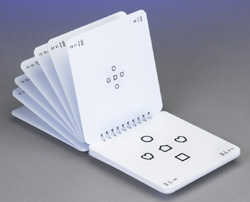LEA SYMBOLS®
Crowded Symbol Book
#250700

The CROWDED SYMBOL BOOK (#250700) is a variant of the line test for children/adults who cannot concentrate on looking at a line test chart. The symbols are arranged so that the centre symbol is surrounded on all four sides by symbols of similar size. The interaction between the centre symbol and the surrounding symbols is approximately the same as in a line test. The test has a convenient size and is easy to handle when screening or when used during home visits and other similar test situations. It is usually the first line test that can be used to measure visual acuity of a young, visually impaired or amblyopic child thus revealing the effect of crowding.
Instructions
-
First establish a method of communication such as naming (signing) or pointing (matching). Decide with the child which names will be used to identify the symbols. Train with the use of the Response Key Card (#251700), Training Cards (#251900), or Flash Cards (#251800). The 3-dimensional LEA 3-D Puzzle may be needed to make the participation in the test situation motivating enough.
-
Show the largest symbol size at near distance and then move backward 3 meters (10 feet), while watching for signs of inattention. If the child's attention/visual sphere is limited, move closer to the child. To make the calculations easy, use 1.5 m or 1 m distance. Always measure well within the child's cognitive visual sphere, the space within which the use of vision is possible.
-
Show one page in each symbol size, and ask the child to identify only the symbol on the left. Continue until the child hesitates or gives a wrong answer. Turn back to the previous symbol size pages and show all four pages, one at a time. Ask the child what the symbol on the left is and then what the next picture is (the one in the middle).
-
If the child responds correctly to three out of the four middle symbols on the four pages, go on to the pages with the next smaller size symbols.
-
If the child responds correctly to two out of the four middle symbols on the four pages, flip back to one of the previously read pages of the same symbol size and give a fifth choice. The visual acuity threshold is defined as the last level (symbol size) where at least three out of five middle symbols were identified correctly.
-
If the child correctly identifies only two of the five symbols, report visual acuity as that of the previous larger symbol size. To get more information for follow-up examinations, write down (+2) after visual acuity value to record that the child identified two middle symbols correctly in the next smaller size. For example, "20/32(+2)" indicates the child passed the 20/32 line and also correctly named two middle symbols on the 20/25 line.
Testing at Different Distances
If the test is used at a distance other than the usual 3
meters (10 feet), measure and record the viewing distance
and the symbol size (the M-value*).
|
|
Examples:
If the viewing distance used was 6 feet (180 cm) and the smallest
optotypes correctly recognized were on line 20/50 (0.4).
|
|
Note that it is incorrect to report ‘ V.A. 20/25 at 5feet’ if the child could read the 20/25 (10/12.4)-line (3.8M line) at 5 feet. Visual acuity is in that case: 5’/10’ x 20/25 = 1/2 x 20/25 = 20/50. (When using the British notation: 6/9 line at 150cm equals: 1.5m/3m x 6/9 = 1/2 x 6/9 = 6/18. When using the decimal notation 0.8 line at 1.5m equals 1.5m/3m x 0.8 = 1/2 x 0.8 = 0.4)
When the distance is one half (or one third) of the standard distance, the visual acuity value is also one half (one third) of the value printed next to that line.
If you do not want to do the calculations, report the result as M-unit value, i.e. in the previous case 3.8M at 5 feet (1.5m). Visual acuity is easy to calculate based on these values:
VA = 1.5m/3.8M = 0.4 (=40/100=20/50).
The calculation is based on metric measurements. The corresponding visual acuity values in the American and in the British notation you find on the visual acuity chart.
If the exactly corresponding value is not printed on the chart, calculate it as follows:
For example 0.07= 7/100= [7x3/100x3]=21/300 or 20/300;
or for the British notation: 0.07=7/100=6/86 (6x100/7=86)
You multiply both the numerator and the denominator with the number that makes the numerator equal or closely equal to 20 or 6.
Always remember to write down which test you used and at which distance. This makes the follow-up more reliable, even if the child moves to another town and therefore to an office of another doctor.
*M-unit, metric unit is the distance in meters at which the reference optotype C is seen at a visual angle of 5'.
[ Instructions I Paediatric Vision Tests I Vision Tests ]
This document was last modified on